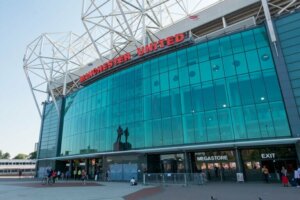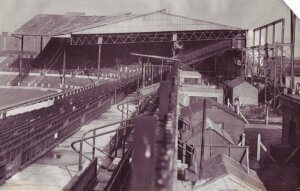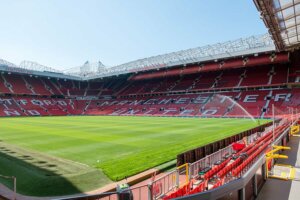A Brief History of Old Trafford

The Theater of Dreams is one of the best-known stadiums in the world. More than 100 years old, Old Trafford stadium in Manchester has witnessed many incredible events, finals, and even the Olympic Games. In this article, we’ll tell you everything you need to know about this legendary venue.
The beginnings of Old Trafford
Old Trafford is the home of Manchester United, who originally had the name ‘Newton Heath’ and played on a rather poor pitch on Bank Street. In 1909, after renaming themselves Manchester United, the chairman donated the money to build a stadium.
Of course, the budget wasn’t huge, so the chosen site was located on Warwick Road in the Old Trafford district of Manchester. The stadium was designed by a Scottish architect named Archibald Leitch and was originally planned for 100,000 spectators, with covered seating on the south stand and three terraces.
As the project progressed, expenses increased and capacity had to be reduced. But this wasn’t enough and they resorted to asking for a subsidy from the Cheshire Lines Committee, who had a warehouse next to the site.
The company refused because they wanted to build a station there. So, Manchester United had to look for another source of cash. Funnily enough, however, the subsequent station only served to transport all the fans on match days.

The stadium was finally complete in 1909 and opened in February 1910 with a match against Liverpool. The somewhat ungracious guests beat the hosts 4-3, something which was slightly unusual for an inauguration.
Up until 1923 (when Wembley was built), Old Trafford also hosted some FA Cup finals (venues were rotated). One of the most memorable matches of that period was between the Reds and Aston Villa in front of a crowd of more than 70,000 people. Sadly, the hosts lost 3-1.
Bombing and reconstruction
During World War II, the military used Old Trafford as a warehouse and therefore suffered a bombing raid by the Germans in 1940. Repairs put the stadium back in good condition in 1941, but soon after, another German bombing raid largely destroyed it.
Whilst the stadium was undergoing reconstruction, the Reds played their home matches at Maine Road, home of their rivals, Manchester City. This meant that they had to pay a high rental price. When Old Trafford reopened in 1949, something had changed: it had no roof. The first match played at the new Old Trafford saw the Reds win 3-0 against Bolton Wanderers.
In 1951, the roofing was finished and the three stands that hadn’t previously been repaired were covered. Lighting was also installed so that matches could be played at night. In 1965, further renovation changed the old roof pillars and improved the seating organization. Following these changes, Old Trafford better contained the ‘noise’ of the crowd to frighten rivals.

An interesting fact about the stadium’s capacity is that the original planned capacity was for 100,000 people, but it was reduced to 80,000 due to tight funds. After the repairs, it had reduced further to 60,000, and in the 1990s, when the law made seating mandatory for all spectators, it only housed 44,000. This meant that the stadium required expansion works. When they were complete in 2006, the capacity reached nearly 75,000.
Today, Old Trafford has four stands: Sir Alex Ferguson (north) stand, Sir Bobby Charlton (south) stand, the Stretford End (west), and the east stand.
A tour around Old Trafford
Now that you know a little about the history of this legendary stadium, you simply have to visit it should you ever travel to Manchester. A guided tour is available, including a museum with the club’s rich history, which was founded in 1878.
You can also see all the trophies that Manchester United have won. One of the most popular places is the club’s ‘legends’ corner’, including Ferguson, Charlton, Cantona, Law, and Best.

Of course, there’s also space commemorating the victims of the Munich Tragedy. In 1958, the Reds were returning from Belgrade, and their plane stopped in Munich. Attempting to take off in poor weather, the plane crashed, killing players and managers, journalists, and supporters.
The tour of Old Trafford lasts two hours and includes admission to various parts of the stadium, such as the bench and the locker rooms. It’s really worth it even if you’re not a fan of the Red Devils!
The Theater of Dreams is one of the best-known stadiums in the world. More than 100 years old, Old Trafford stadium in Manchester has witnessed many incredible events, finals, and even the Olympic Games. In this article, we’ll tell you everything you need to know about this legendary venue.
The beginnings of Old Trafford
Old Trafford is the home of Manchester United, who originally had the name ‘Newton Heath’ and played on a rather poor pitch on Bank Street. In 1909, after renaming themselves Manchester United, the chairman donated the money to build a stadium.
Of course, the budget wasn’t huge, so the chosen site was located on Warwick Road in the Old Trafford district of Manchester. The stadium was designed by a Scottish architect named Archibald Leitch and was originally planned for 100,000 spectators, with covered seating on the south stand and three terraces.
As the project progressed, expenses increased and capacity had to be reduced. But this wasn’t enough and they resorted to asking for a subsidy from the Cheshire Lines Committee, who had a warehouse next to the site.
The company refused because they wanted to build a station there. So, Manchester United had to look for another source of cash. Funnily enough, however, the subsequent station only served to transport all the fans on match days.

The stadium was finally complete in 1909 and opened in February 1910 with a match against Liverpool. The somewhat ungracious guests beat the hosts 4-3, something which was slightly unusual for an inauguration.
Up until 1923 (when Wembley was built), Old Trafford also hosted some FA Cup finals (venues were rotated). One of the most memorable matches of that period was between the Reds and Aston Villa in front of a crowd of more than 70,000 people. Sadly, the hosts lost 3-1.
Bombing and reconstruction
During World War II, the military used Old Trafford as a warehouse and therefore suffered a bombing raid by the Germans in 1940. Repairs put the stadium back in good condition in 1941, but soon after, another German bombing raid largely destroyed it.
Whilst the stadium was undergoing reconstruction, the Reds played their home matches at Maine Road, home of their rivals, Manchester City. This meant that they had to pay a high rental price. When Old Trafford reopened in 1949, something had changed: it had no roof. The first match played at the new Old Trafford saw the Reds win 3-0 against Bolton Wanderers.
In 1951, the roofing was finished and the three stands that hadn’t previously been repaired were covered. Lighting was also installed so that matches could be played at night. In 1965, further renovation changed the old roof pillars and improved the seating organization. Following these changes, Old Trafford better contained the ‘noise’ of the crowd to frighten rivals.

An interesting fact about the stadium’s capacity is that the original planned capacity was for 100,000 people, but it was reduced to 80,000 due to tight funds. After the repairs, it had reduced further to 60,000, and in the 1990s, when the law made seating mandatory for all spectators, it only housed 44,000. This meant that the stadium required expansion works. When they were complete in 2006, the capacity reached nearly 75,000.
Today, Old Trafford has four stands: Sir Alex Ferguson (north) stand, Sir Bobby Charlton (south) stand, the Stretford End (west), and the east stand.
A tour around Old Trafford
Now that you know a little about the history of this legendary stadium, you simply have to visit it should you ever travel to Manchester. A guided tour is available, including a museum with the club’s rich history, which was founded in 1878.
You can also see all the trophies that Manchester United have won. One of the most popular places is the club’s ‘legends’ corner’, including Ferguson, Charlton, Cantona, Law, and Best.

Of course, there’s also space commemorating the victims of the Munich Tragedy. In 1958, the Reds were returning from Belgrade, and their plane stopped in Munich. Attempting to take off in poor weather, the plane crashed, killing players and managers, journalists, and supporters.
The tour of Old Trafford lasts two hours and includes admission to various parts of the stadium, such as the bench and the locker rooms. It’s really worth it even if you’re not a fan of the Red Devils!
All cited sources were thoroughly reviewed by our team to ensure their quality, reliability, currency, and validity. The bibliography of this article was considered reliable and of academic or scientific accuracy.
- Manchester United. Company Information, History. Sitio oficial del Manchester United. https://ir.manutd.com/company-information/history.aspx
- Old Trafford. The Stadium Guide. https://www.stadiumguide.com/oldtrafford/
- Gil, M. Old Trafford se manifiesta. Mundo Deportivo. Febrero 2020. https://www.mundodeportivo.com/futbol/premier-league/20200125/473112876642/old-trafford-protesta-manchester-united-wolves-aficion-familia-glazer-ed-woodward-solskjaer.html
This text is provided for informational purposes only and does not replace consultation with a professional. If in doubt, consult your specialist.








